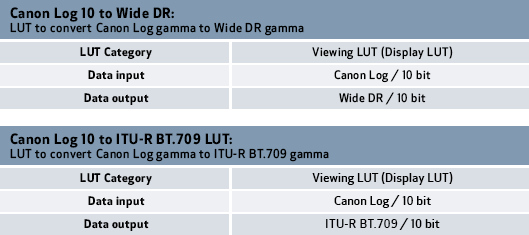What LUT do I choose? (EOS 5D Mark IV)
| Article ID: ART168334 |
| |
Date published: 08/03/2017 |
| |
Date last updated: 06/21/2019 |
Description
On the EOS 5D Mark IV with Canon Log, which LUT should I choose and when?
Solution
The Canon Log feature includes two Look Up Tables (LUTs) that correct the recorded image's gamma and color space when viewed on an external monitor. With Canon Log 10 to Wide DR LUT, the video file is converted to Wide Dynamic Range gamma, with well-preserved highlights and shadow detail. With Canon Log 10 to ITU-R BT.709 LUT, the file is converted to ITU-R BT.709, providing conventional camcorder specs for viewing in a color space consistent with an HDTV.
 While these tables show LUTs based on 10-bit input, the output for an EOS 5D Mark IV camera featuring Canon Log is 8-bit.
While these tables show LUTs based on 10-bit input, the output for an EOS 5D Mark IV camera featuring Canon Log is 8-bit.
In summary...
- Canon Log 10 to Wide DR LUT provides a view of the footage that has a wider dynamic range, which preserves highlights and shadows. This is recommended if the intent is to simulate how the processed footage would look with a wider dynamic range on a professional monitor.
- Canon Log 10 to ITU-R BT.709 LUT is a viewing LUT that provides a view of the footage that has been converted to the standard color space and gamma that HDTV's use. This is ideal if the intent is to distribute the footage for viewing on a HDTV, which has a more limited color space and gamma.
Both LUTs provide "processed" views of the Canon Log footage and simulates what it would look like after post grading has occurred. The LUTs are viewing LUTs, meaning that they do not alter the recorded footage but instead applies the LUT to give a simulated view of the footage.
NOTE: The View Assist feature of the EOS 5D Mark IV applies a Wide DR LUT for viewing the footage on the camera's LCD panel, while recording Canon Log to the memory card. The signal provided by the HDMI terminal is not affected by the View Assist feature.